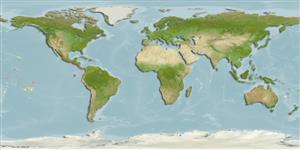Teleostei (teleosts) >
Eupercaria/misc (Various families in series Eupercaria) >
Haemulidae (Grunts) > Haemulinae
Etymology: Anisotremus: Greek, anisos = unequal + Greek, trema, -atos = hole (Ref. 45335).
More on author: Gill.
Environment: milieu / climate zone / depth range / distribution range
Ecology
Marine; reef-associated; depth range 3 - 30 m (Ref. 5227), usually 3 - 12 m (Ref. 5227). Tropical; 22°N -
Eastern Pacific: Gulf of California to Peru, including the Galapagos Islands.
Size / Weight / Age
Maturity: Lm ? range ? - ? cm
Max length : 51.0 cm TL male/unsexed; (Ref. 55763); common length : 30.0 cm TL male/unsexed; (Ref. 9114); max. published weight: 3.6 kg (Ref. 40637)
Body compressed and deep (depth contained 2.0 to 2.1 times in standard length); mouth small and terminal with thick, fleshy lips; dorsal fin with 12 to 13 spines and 16 to 17 soft rays (XII-XIII, 16-17); pectoral fins slightly longer than head, reaching origin of anal fin; lateral line with 46 to 50 scales; scale series above lateral line oblique; body silvery yellow to green; large scales above lateral line with a dark anterior border, resembling spots; fins yellowish brown (Ref. 55763).
Solitary and found hiding in reefs and caves during the day (Ref. 9114). Juveniles appear in late summer and swim in schools. A nocturnal feeder on reef invertebrates (Ref. 9114). Marketed fresh (Ref. 9114).
Life cycle and mating behavior
Maturities | Reproduction | Spawnings | Egg(s) | Fecundities | Larvae
Distinct pairing during breeding (Ref. 205).
Thomson, D.A., 1987. Reef fishes of the Sea of Cortez. The rocky-shore fishes of the Gulf of California. The University of Arizona Press, Tucson. 302 p. (Ref. 5592)
IUCN Red List Status (Ref. 130435)
Threat to humans
Harmless
Human uses
Fisheries: commercial
Tools
Special reports
Download XML
Internet sources
Estimates based on models
Preferred temperature (Ref.
123201): 23.5 - 29.1, mean 28 °C (based on 161 cells).
Phylogenetic diversity index (Ref.
82804): PD
50 = 0.5039 [Uniqueness, from 0.5 = low to 2.0 = high].
Bayesian length-weight: a=0.02630 (0.01483 - 0.04666), b=3.06 (2.90 - 3.22), in cm total length, based on LWR estimates for this species & (Sub)family-body (Ref.
93245).
Trophic level (Ref.
69278): 3.5 ±0.37 se; based on food items.
Generation time: 8.5 ( na - na) years. Estimated as median ln(3)/K based on 1
growth studies.
Resilience (Ref.
120179): Low, minimum population doubling time 4.5 - 14 years (K=0.13).
Fishing Vulnerability (Ref.
59153): High vulnerability (58 of 100).
Nutrients (Ref.
124155): Calcium = 27.6 [13.1, 55.2] mg/100g; Iron = 0.482 [0.246, 0.892] mg/100g; Protein = 18.8 [16.8, 20.8] %; Omega3 = 0.0898 [, ] g/100g; Selenium = 32.1 [17.0, 60.7] μg/100g; VitaminA = 58.3 [16.4, 196.7] μg/100g; Zinc = 1.02 [0.66, 1.52] mg/100g (wet weight);
